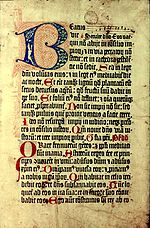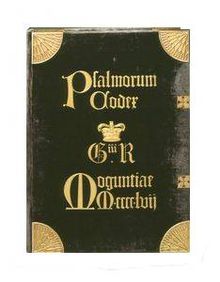- Mainz Psalter
-
The Mainz Psalter is the earliest dated example of printed matter issuing from the new moveable-print technology of Johannes Gutenberg. It was a psalter ordered by the Mainz archbishop in AD 1457. It combines printed text with two-color woodcuts (since both woodcuts and moveable print are relief processes, they could be printed together on the same press). The Psalter is printed on vellum using black and red inks, with two-color initials, manuscript music, and large colored capitals printed in blue and red inks.[1]
Contents
Earliest dated material
Other material had been printed by Gutenberg's shop before 1457 (the Gutenberg Bible was printed in 1455), and it is possible that some of these other manuscripts are also still extant. However, scholars are in general agreement that the Mainz Psalter is the oldest printed document to carry a verifiable date. The date of August 15th (1457) is celebrated as the day of completion of the Mainz Psalter.[2]
The Mainz Psalter is also credited with carrying the world's first colophon, a page after the text which bears the publisher's name and other information concerning the publication.[3]
Introduction
An English translation of the Psalter's Introduction Page is given below. It shows the pride which the printers felt in their accomplishment:
- This volume of the Psalms, adorned with a magnificence of capital letters and clearly divided by rubrics, has been fashioned by a mechanical process of printing and producing characters, without use of a pen, and it was laboriously completed, for God's Holiness, by Joachim Fust, citizen of Mainz, and Peter Schoeffer of Gernsheim, on Assumption Eve in the year of Our Lord, 1457.[4]
Style
The Mainz Psalter's text does not resemble today's books as much as it does a handwritten document of the sixteenth century. It contains more than the 23 letters of that era's German language; there are lines above some letters; some letters are joined together; and some letters are used as shorthand for complete words. It appears that the typesetters attempted to duplicate handwriting mannerisms that would be familiar to readers of the day.
The music (meant to accompany the Psalms) was written in a beautiful flowing manuscript, and scholars have suggested that this manuscript was the model for the mechanical letters.[5]
Printing in two colors, although feasible on the moveable press of Gutenberg's time (as illustrated by the Mainz Psalter), was apparently abandoned soon afterward as being too time-consuming, as few other examples of such a process are extant.[6]
Existing copies
There are 10 copies, in two versions, of the Mainz Psalter still existing (2009). There are 6 short issues printed for general use, and 4 longer ones (of 175 leaves) intended for use in the Mainz diocese.[7]
Digitized copy at Austrian National Library: Mainz Psalter
One copy of the Mainz Psalter, being held at the Saechsische Landesbibliothek (Dresden State Library of Saxony) up to World War II, was apparently looted during the war and carried to the United States by persons unknown. After it was identified in New York City by US Government authorities, it was returned to Germany on a plane carrying the Honorable John J. McCloy, US High Commissioner on 13 March 1950.[8]
-
References
- ^ http://www.royalcollection.org.uk/eGallery/object.asp?object=1071478&row=0&detail=about
- ^ http://www.brainyhistory.com/events/1457/august_15_1457_32686.html
- ^ http://www.papress.com/thinkingwithtype/teachers/type_lecture/history_mainz_psalter.htm
- ^ Connections (TV series), "Connections" by James Burke, p. 100
- ^ http://www.royalcollection.org.uk/eGallery/object.asp?object=1071478&row=0&detail=about
- ^ http://www.gutenberg-museum.de/index.php?id=74&language=e
- ^ http://www.royalcollection.org.uk/eGallery/object.asp?object=1071478&row=0&detail=about
- ^ http://digicoll.library.wisc.edu/cgi-bin/History/History-idx?type=div&did=HISTORY.OMG1950JUNE.I0005&isize=text
Categories:- 15th-century Christian texts
- Incunabula
- Mainz
- Memory of the World Register
- 1457 books
Wikimedia Foundation. 2010.


